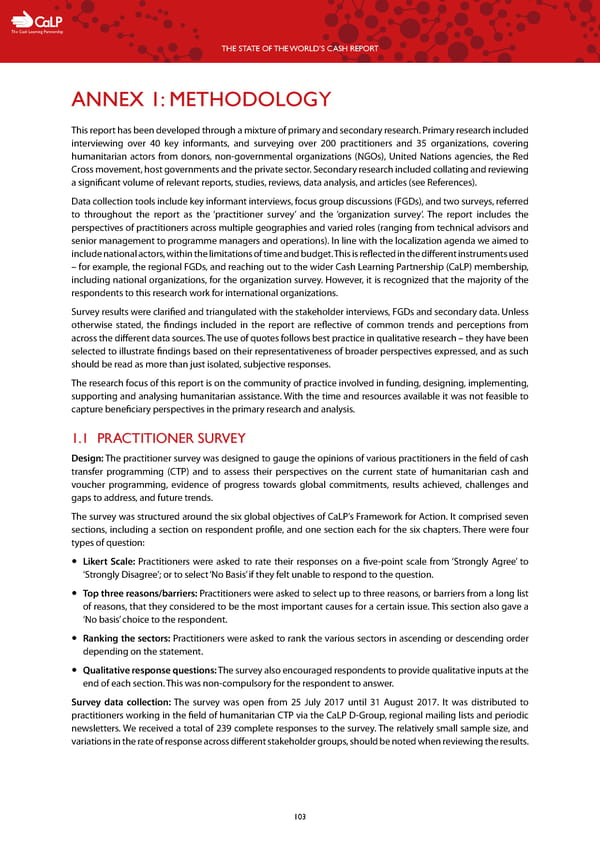C The Cash Learning Partnership THE STATE OF THE WORLD’S CASH REPORT ANNEX 1: METHODOLOGY This report has been developed through a mixture of primary and secondary research. Primary research included interviewing over 40 key informants, and surveying over 200 practitioners and 35 organizations, covering humanitarian actors from donors, non-governmental organizations (NGOs), United Nations agencies, the Red Cross movement, host governments and the private sector. Secondary research included collating and reviewing a significant volume of relevant reports, studies, reviews, data analysis, and articles (see References). Data collection tools include key informant interviews, focus group discussions (FGDs), and two surveys, referred to throughout the report as the ‘practitioner survey’ and the ‘organization survey’. The report includes the perspectives of practitioners across multiple geographies and varied roles (ranging from technical advisors and senior management to programme managers and operations). In line with the localization agenda we aimed to include national actors, within the limitations of time and budget. This is reflected in the different instruments used – for example, the regional FGDs, and reaching out to the wider Cash Learning Partnership (CaLP) membership, including national organizations, for the organization survey. However, it is recognized that the majority of the respondents to this research work for international organizations. Survey results were clarified and triangulated with the stakeholder interviews, FGDs and secondary data. Unless otherwise stated, the findings included in the report are reflective of common trends and perceptions from across the different data sources. The use of quotes follows best practice in qualitative research – they have been selected to illustrate findings based on their representativeness of broader perspectives expressed, and as such should be read as more than just isolated, subjective responses. The research focus of this report is on the community of practice involved in funding, designing, implementing, supporting and analysing humanitarian assistance. With the time and resources available it was not feasible to capture beneficiary perspectives in the primary research and analysis. 1.1 PRACTITIONER SURVEY Design: The practitioner survey was designed to gauge the opinions of various practitioners in the field of cash transfer programming (CTP) and to assess their perspectives on the current state of humanitarian cash and voucher programming, evidence of progress towards global commitments, results achieved, challenges and gaps to address, and future trends. The survey was structured around the six global objectives of CaLP‘s Framework for Action. It comprised seven sections, including a section on respondent profile, and one section each for the six chapters. There were four types of question: — Likert Scale: Practitioners were asked to rate their responses on a five-point scale from ‘Strongly Agree’ to ‘Strongly Disagree’; or to select ‘No Basis’ if they felt unable to respond to the question. — Top three reasons/barriers: Practitioners were asked to select up to three reasons, or barriers from a long list of reasons, that they considered to be the most important causes for a certain issue. This section also gave a ‘No basis’ choice to the respondent. — Ranking the sectors: Practitioners were asked to rank the various sectors in ascending or descending order depending on the statement. — Qualitative response questions: The survey also encouraged respondents to provide qualitative inputs at the end of each section. This was non-compulsory for the respondent to answer. Survey data collection: The survey was open from 25 July 2017 until 31 August 2017. It was distributed to practitioners working in the field of humanitarian CTP via the CaLP D-Group, regional mailing lists and periodic newsletters. We received a total of 239 complete responses to the survey. The relatively small sample size, and variations in the rate of response across different stakeholder groups, should be noted when reviewing the results. 103
 The State of the World's Cash | Full Report Page 104 Page 106
The State of the World's Cash | Full Report Page 104 Page 106